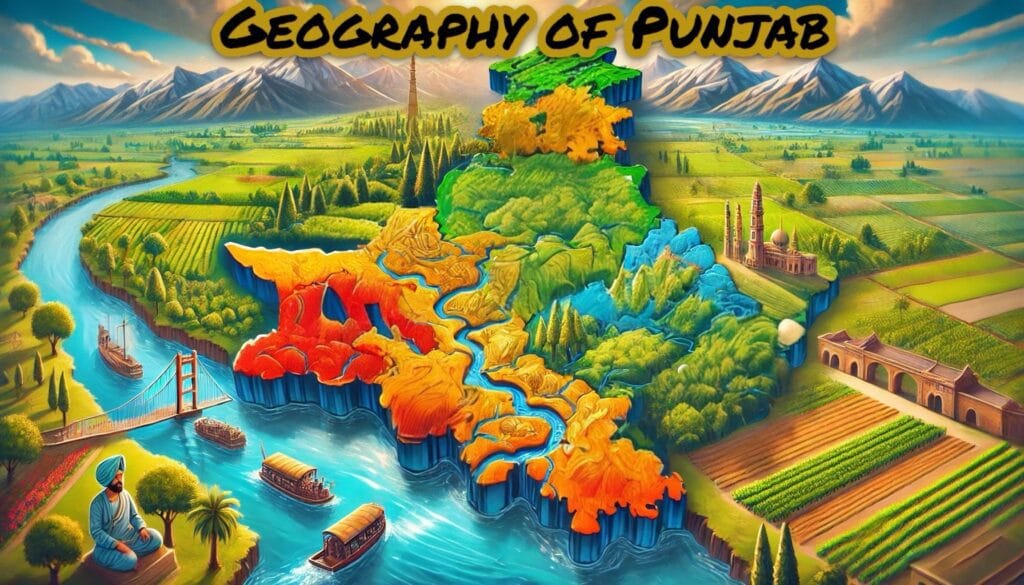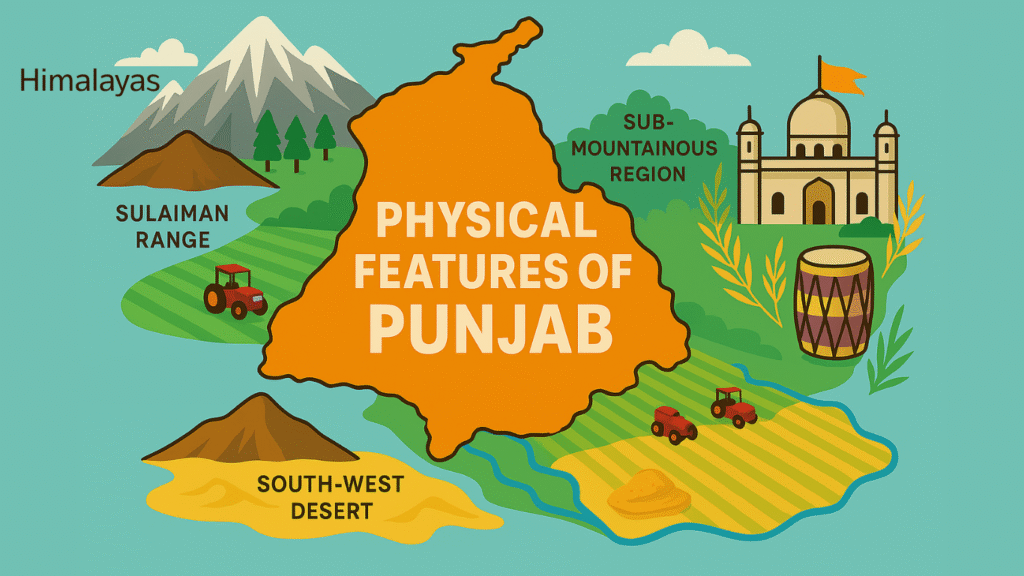
Punjab, one of the wealthiest states of India in terms of natural resources and economic prosperity, is situated in the northwestern part of the country. Physical features of Punjab, extends from 29° 30′ N to 32° 32′ N latitude and 73° 55′ E to 76° 50′ E longitude. The state spans approximately 335 km from Pathankot in the north to Mansa in the south and about 300 km from east to west.
As detailed in our previous article, “Names of Punjab Through Different Time Periods,” Punjab’s geographical characteristics have evolved over time. The state shares an international border with Pakistan, spanning 553 km across six districts. Additionally, it shares its boundaries with Himachal Pradesh to the east, Haryana and Rajasthan to the south . The Union Territory of Jammu & Kashmir (Kathua district) to the north and Chandigarh, also the capital of Punjab, lies within its territorial limits.
Shaped like a triangle, Punjab forms the western segment of the Great Northern Plains, also known as the Satluj-Ganga Plains. Covering an area of 50,362 sq. km, Punjab accounts for 1.54% of India’s total geographical area and ranks 19th in size among the 28 Indian states. It is larger than Haryana, Kerala, Sikkim, Goa (India’s smallest state), and most northeastern states, except Arunachal Pradesh and Assam.
Table of Contents
Physical Features of Punjab
Punjab boasts a fertile landscape, shaped by God’s own hand, making it one of the most agriculturally productive regions in the world. In the north, the Himalayas provide a natural barrier, protecting the region from the cold Siberian winds while also enriching its soil through nutrient-rich silt deposits. The Hoshiarpur district, with the highest forest cover in Punjab, enhances the state’s natural beauty, inspiring poets like Bulleh Shah, Shah Hussain, and Bhai Gurdas Ji.

Punjab’s geographical features can be classified into three main regions:
- The Himalayas and the Sulaiman Mountain Ranges (now in Pakistan)
- The Sub-Mountainous Region
- The Plains
1. The Himalayas and the Sulaiman Mountain Ranges
(i) The Himalayas
The Himalayas, meaning “abode of snow,” stretch across 2,500 km from Assam in the east to Afghanistan in the west, with a width of 240-320 km. These mountains are divided into three regions based on height:
- Great Himalayas (above 20,000 feet): Includes Mount Everest (29,032 ft or 8,848.86 m), the world’s highest peak. In recent days, studies have revealed a slight increase in its height, further fueling interest in this region as a key area of study and exploration.
- Middle Himalayas (10,000-20,000 feet): Hosts popular hill stations like Shimla, Dalhousie, and Kashmir.
- Outer Himalayas (3,000-10,000 feet): Known as the Shivalik Range.
The Himalayas serve as a protective shield, preventing foreign invasions for centuries, ensuring adequate monsoon rainfall, and sustaining holy perennial rivers that enhance Punjab’s fertility.
(ii) Sulaiman Mountain Ranges (Now in Pakistan)
Located in northwestern Punjab (now Pakistan), the Sulaiman Range is strategically significant due to its famous passes, including:
- Khyber Pass (most prominent)
- Bolan Pass
- Kurram Pass
- Tochi Pass
- Gomal Pass
These routes historically facilitated trade and invasions from Afghanistan, Persia, and Turkey into Punjab.
2. The Sub-Mountainous Region
This hilly region lies between the Shivalik Range and Punjab’s plains, also known as Tarai. With elevations between 1,000 and 3,000 feet, it extends 5-12 km along Punjab’s northeastern border. Key districts in this region include Hoshiarpur, Pathankot, Nawanshahr, Rupnagar, parts of Gurdaspur, and Sialkot (Pakistan). Due to its less fertile soil, the population density here is relatively low.
(i) Kandi Region
The Kandi region, a degraded upland area, extends along the Pathankot-Hoshiarpur-Ropar-Chandigarh belt, with variations like:
This region is badly affected and dissected with numerous choes (seasonal and ephemeral streams) and khads (sandy bed of streams). Because of rough, porous, and coarse-grained deposits, numerous choes disappear in the area without joining the major stream or river. It extends in the form of a narrow and long belt along the entire length of the Shiwalik Hills under different names—such as Kandi, Ghar, and Changar.
- Kandi
This region, located between 300 and 400 metres above sea level, serves as a transitional belt between the Shiwalik Hills and the Punjab plains. Characterized by rugged terrain and seasonal streams, the Kandi region plays a crucial role in groundwater recharge and ecological balance.
- Changar (Ropar District)
The Kandi in Anandpur Sahib block of Ropar District is called Changar. It is a strip of land extending along the left hand of river Satluj. It rises abruptly eastwards from Nangal-Ropar road.
- Ghar (Ropar District & Nurpur Bedi Block)
The dissected upland to the west of the Shiwalik Hills in Ropar district and to the south of the Sirsa Nadi is known as Ghar. This region, characterized by its rugged terrain and seasonal streams, faces significant soil erosion and limited agricultural potential. The western part of Nurpur Bedi block, located to the east of the Shiwalik Hills, is also classified as Ghar. Despite its challenging landscape, this area plays a crucial role in groundwater recharge and serves as a buffer zone between the plains and the mountainous regions.
This region is characterized by seasonal streams (choes) and sandy riverbeds (khads), leading to soil erosion and limited agriculture.
3. The Plains
The largest and most fertile region of Punjab, these plains lie between the Indus and Yamuna rivers at an elevation of less than 1,000 feet above sea level. Due to abundant rainfall and developed transport, this region has a high population density. It is further divided into:
(a) The Five Doabs
Derived from the Persian word “Doab” (meaning “land between two rivers”), the Mughal Emperor Akbar classified Punjab into five Doabs:
- Bist Jalandhar Doab (Beas & Sutlej Rivers) – Includes Jalandhar & Hoshiarpur
- Bari Doab (Beas & Ravi Rivers) – Known as Majha; includes Amritsar, Gurdaspur & Lahore (Pakistan)
- Rachna Doab (Ravi & Chenab Rivers) – Includes Gujranwala & Sheikhupura (Pakistan)
- Chaj Doab (Chenab & Jhelum Rivers) – Includes Gujarat & Shahpur (Pakistan)
- Sind Sagar Doab (Jhelum & Indus Rivers) – Includes Rawalpindi (Pakistan)
(b) Malwa and Bangar
This region, lying between Sutlej and Yamuna rivers, is further divided into:
- Malwa (Sutlej & Ghaggar Rivers) – This area, located between the rivers Sutlej and Ghaggar, is called Malwa. The name originates from the ancient Malwa tribe that once resided here, leading to the region being called Malwa and its inhabitants being referred to as Malwai. The main and famous cities of this region, as also discussed in the Punjabi Grammar section, include Ludhiana, Patiala, Sirhind, Sangrur, Malerkotla, Bathinda, and Faridkot.
- The Bangar area, located between the rivers Ghaggar and Yamuna, is also known as Haryana. This region includes historically significant cities such as Ambala, Panipat, Rohtak, Karnal, Kurukshetra, Gurugram, Jind, and Hissar. The Bangar region has been the site of many decisive battles in Indian history, including the three battles of Panipat, which shaped the course of the Indian subcontinent.
(c) South-West Desert or Dune Studded Region
This semi-arid region borders the Thar Desert (Rajasthan), covering Bathinda, Faridkot, Ferozepur, Mansa, Muktsar, and Sangrur. Its sand dunes and ridges, formed due to Sutlej and Ghaggar River actions, are locally called “Tibbas.”
Punjab’s rich geography has shaped its history, agriculture, and culture. From Himalayan peaks to fertile plains, each region plays a crucial role in its prosperity. Understanding Punjab’s physical features provides valuable insights for competitive exams like PSSSB, PCS, Punjab Patwari, and Punjab Police.
FAQs
1. What is the geographical location of Punjab?
Punjab is located in northwestern India, between 29° 30′ N to 32° 32′ N latitude and 73° 55′ E to 76° 50′ E longitude.
2. Which states and countries share a border with Punjab?
Punjab shares its border with Pakistan (553 km), Himachal Pradesh, Haryana, Rajasthan, and Jammu & Kashmir.
3. What are the main physical features of Punjab?
Punjab is divided into three main geographical regions:
The Himalayas and Sulaiman Mountain Ranges
The Sub-Mountainous Region
The Plains (Doabs, Malwa, and Bangar)
4. What is the significance of the Himalayas for Punjab?
The Himalayas provide protection from cold winds, contribute to rainfall, and are the source of rivers that make Punjab’s land fertile.
5. What is the Kandi region in Punjab?
The Kandi region is a narrow, long belt along the Shivalik Hills, also known as Changar in Anandpur Sahib and Ghar in parts of Ropar district.
6. What are the five Doabs of Punjab?
Punjab is historically divided into five Doabs, named after the rivers between them:
Bist Jalandhar Doab (Beas-Sutlej)
Bari Doab (Beas-Ravi)
Rachna Doab (Ravi-Chenab)
Chaj Doab (Chenab-Jhelum)
Sind Sagar Doab (Jhelum-Indus)
7. What is the Malwa region of Punjab?
The Malwa region lies between the Sutlej and Ghaggar rivers, named after the Malwa tribe. Major cities include Ludhiana, Patiala, and Bathinda.
8. What is the Bangar region, and why is it historically important?
The Bangar region, also known as Haryana, lies between Ghaggar and Yamuna rivers. It was the site of important battles, including the three battles of Panipat.
9. Why is Punjab’s soil considered fertile?
Punjab’s plains are enriched by alluvial deposits from Himalayan rivers, making it one of India’s most agriculturally productive states.
10. What is the South-West Desert region of Punjab?
The semi-arid region bordering Rajasthan’s Thar Desert includes Bathinda, Faridkot, Ferozepur, and Mansa, with sand dunes locally known as Tibbas.
